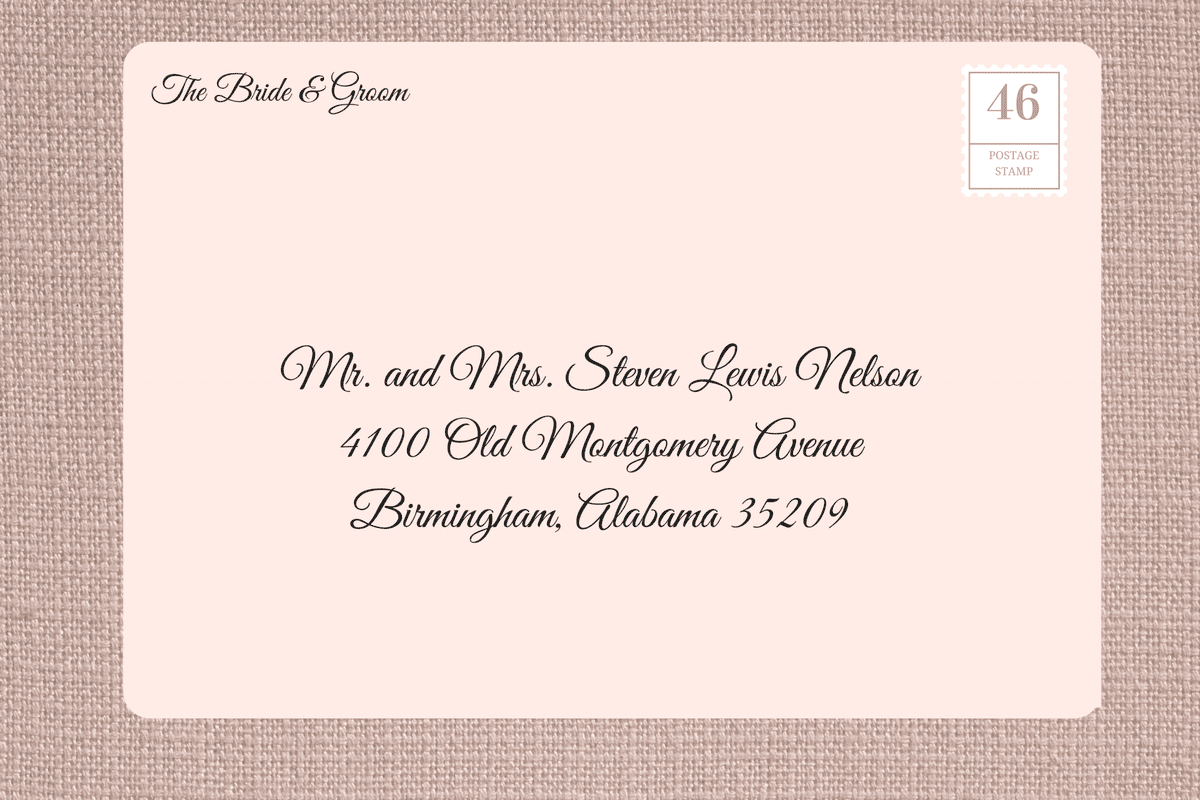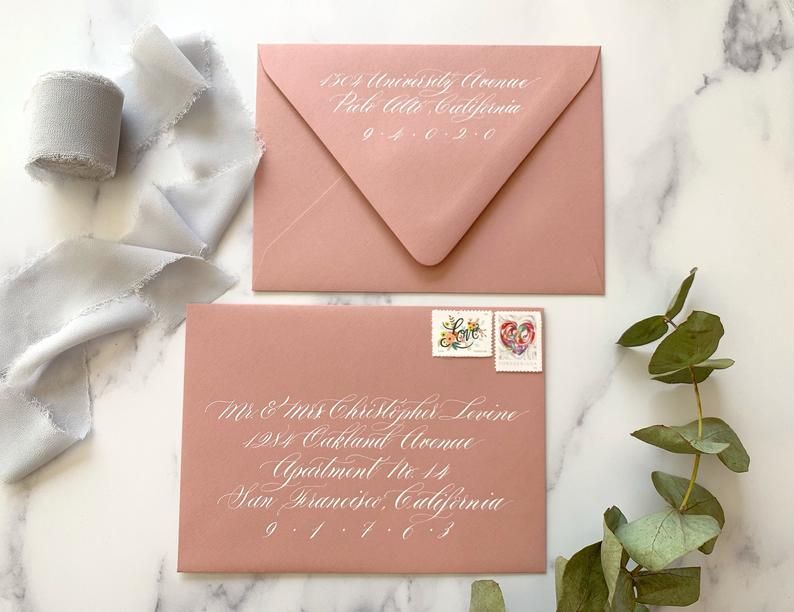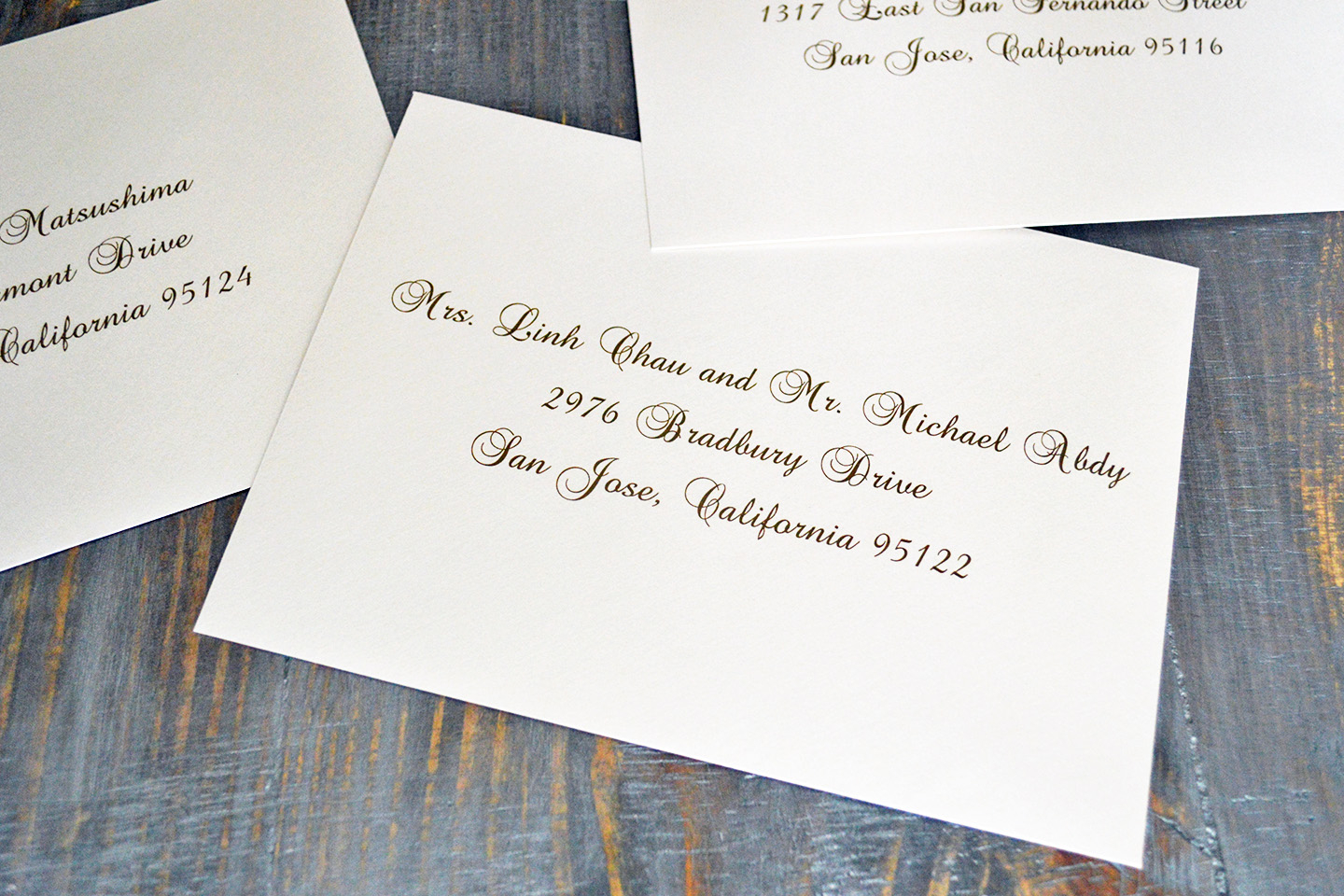Addressing Formal Wedding Invitations

Outer Envelope:

-
Married Couple:

- Mr. and Mrs. [Groom’s First and Last Name]
- 123 Main Street
- Anytown, CA 12345
-
Unmarried Couple Living Together:
- Ms. [Bride’s First and Last Name] and Mr. [Groom’s First and Last Name]
- 123 Main Street
- Anytown, CA 12345
-
Parents’ Home Address:
- Mr. and Mrs. [Bride’s Father’s First and Last Name]
- 123 Main Street
- Anytown, CA 12345
Inner Envelope:
-
Married Couple:
- [Bride’s First Name] and [Groom’s First Name] [Last Name]
-
Unmarried Couple Living Together:
- [Bride’s First Name] [Last Name] and [Groom’s First Name] [Last Name]
Special Considerations:
-
Two Last Names: If either the bride or groom has two last names, use both names on the inner envelope and include the appropriate title (e.g., Mr. or Ms.).
-
Junior/Senior: Use “Jr.” or “Sr.” after the full name of the person being addressed if applicable.
-
Military Salutations: Use the appropriate military salutation (e.g., Captain, Lieutenant) followed by the full name and rank of the recipient.
-
Titles: If the recipients have professional titles (e.g., Dr., Judge), include the title before the name on the outer envelope, but not on the inner envelope.
Addressing Informal Wedding Invitations
For informal invitations, you can use a more relaxed style of addressing. Consider using first names only, nicknames, or personal salutations.
Outer Envelope:
- [Bride’s First Name] [Last Name] and [Groom’s First Name] [Last Name]
- [Bride’s Nickname] and [Groom’s Nickname]
- Hey there, [Guest Names]!
Inner Envelope:
- [Bride’s First Name] and [Groom’s First Name]
- [Guest Names]## Addressing Wedding Invitations
Executive Summary
Addressing wedding invitations is a crucial step in the planning process that requires careful attention to detail and etiquette. By understanding the rules and guidelines for addressing invitations, you can ensure that your guests receive their invitations promptly and in a professional manner. This comprehensive guide will provide you with all the information you need to address wedding invitations correctly, including FAQs, subtopics, and examples.
Introduction
Wedding invitations serve as the formal announcement of your upcoming marriage and provide essential information to your guests. Proper addressing ensures that the invitations are delivered to the correct recipients and creates a positive first impression.
FAQs
1. When should I start addressing invitations?
Start addressing invitations 6-8 weeks before the wedding to allow ample time for preparation, mailing, and any necessary corrections.
2. Can I use a computer font to address invitations?
While it is acceptable to use a computer font, it is recommended to use traditional calligraphy or a formal font to maintain a sophisticated and elegant look.
3. Should I include the return address on the invitation envelopes?
Yes, include a return address on the back flap of the invitation envelopes so that guests can easily RSVP or contact you if needed.
Subtopics
1. Addressing the Outer Envelope
- Guest Name: Write the guest’s full name, including any titles (Mr., Mrs., Dr., etc.)
- Household/Family Name: If addressing a couple or family, write the surname first
- Street Address: Include the street address, apartment number, and city and state
- Zip Code: Use the standard format (e.g., 12345)
- Stamp: Affix a postage stamp in the upper right corner
2. Addressing the Inner Envelope
- Guest Name: Repeat the guest’s full name, including titles and any “and Guest” notation
- Formal Greeting: Include a formal greeting such as “Dear Mr. and Mrs. Smith”
- RSVP Information: Print the RSVP instructions and contact information for the guest to respond with their acceptance or regrets
3. Addressing Different Relationships
- Couples: Use the title “Mr. and Mrs.” or “Ms. and Mr.” followed by the surname
- Families with Children: Include the parents’ names and the children’s names below, using “and family”
- Single Guests: Use the guest’s full name with the title “Mr.” or “Ms.”
- Plus Ones: If allowing guests to bring a companion, write “and guest” after the primary guest’s name
- Unmarried Couples: Use separate envelopes and address them to each individual, with the notation “and guest” on the companion’s envelope
4. Special Considerations
- Married Couples with Different Surnames: Include both surnames, separated by a slash or hyphen
- Deceased Relatives: Address invitations to the surviving spouse or a designated family member
- Military Personnel: Follow specific guidelines for addressing invitations to active or retired military members
- Foreign Addresses: Use the appropriate postal format for the country of the recipient
- Return Address for Overseas Guests: Provide a return address in the local language and format
5. Examples of Properly Addressed Envelopes
Outer Envelope:
Mr. and Mrs. John Smith
123 Main Street, Apt. 301
Anytown, CA 12345
Inner Envelope:
Dear Mr. and Mrs. Smith,
Please RSVP by June 15th, 2024
[RSVP Contact Information]
Conclusion
Addressing wedding invitations with accuracy and attention to detail is essential for creating a memorable and professional first impression for your guests. By following the guidelines and tips provided in this guide, you can ensure that your invitations arrive as intended and set the tone for a successful celebration. Remember to start early, use formal and legible writing, and pay attention to the special considerations for different relationships and situations. With proper addressing, you can invite your guests in style and create a lasting keepsake of your special day.
Keyword Tags
- Wedding Invitation Addressing
- Outer Envelope Addressing
- Inner Envelope Addressing
- Relationship Address Conventions
- Special Address Considerations







